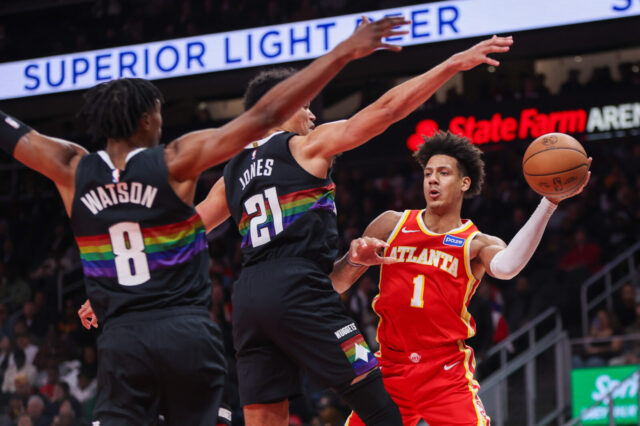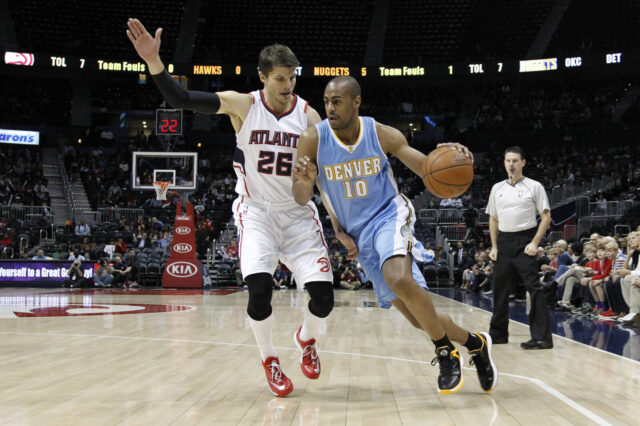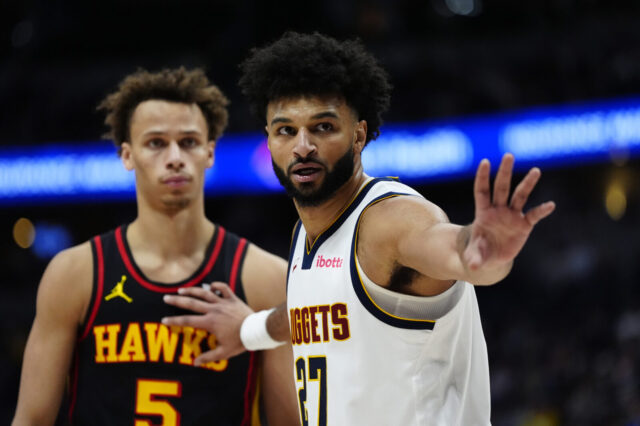Shaquille O’Neal is responsible for why Denver Nuggets superstar center Nikola Jokic doesn’t get the “benefit of the doubt” foul calls that other superstars do.
I hear you chuckling after you read that. Fine. Don’t believe me? Let me explain.
It may seem counterintuitive to assert that a player who retired 4 years before Jokic was even drafted and who’s prime ended before the Serbian savant was 10 years old would matter to the pace and space heavy NBA. If there was ever a player who was the antithesis of the threes heavy, guard and wing dominated league we have in 2025 it is Shaq. Hell it’s even hard to draw a correlation between their style’s of play.
However, a 2001 era NBA that struggled to properly and fairly officiate it’s most dominant player led to the most consequential court altering rules changes since the adoption of the three point line in 1980. A league that could call a foul either way (on every play) on their best and most notable player in the immediate aftermath of Michael Jordan decided to fundamentally change the game. No hyperbole from yours truly. The NBA decided to not engage with how the officials called fouls on Shaq, they decided to make his skill set obsolete.

In the offseason of 2001 the rules committee of the NBA Board of Governors — led by then Phoenix Suns owner Jerry Colangelo who, maybe not coincidentally, had a guard dominated team — took away the long-standing “illegal defense” penalty (which effectively disallowed zone defense) and replaced it with defensive and offensive three seconds. Essentially dictating that a back to the basket space occupying big men such as Shaquille O’Neal be pushed farther outside the lane. Also the league redefined contact that was allowable by a defender (this was the beginning of the big crackdown on hand checking).
The NBA has “juiced” offensive basketball several times in its history, including widening the lane multiple times to where it sits now. This is not unusual. Yet, in 2001 the league chose to fundamentally alter its character in a way that still reverberates today.
This didn’t come in response to Shaq’s brilliant MVP season of 1999-00. It occurred after the Los Angeles Lakers went 15-1 and steamrolled over every team in the NBA playoffs. A playoff stretch by O’Neal that might be one of the most dominant we have ever seen by a center up to that point; averaging 30 points and 15 rebounds in 16 games in an era where scoring 100 points was considered high. This culminated in the Lakers second straight title and a second Finals MVP for Shaq.
Still, the league was concerned. Despite Finals ratings being consistently good, the regular season ratings had fallen since Jordan retired. Some of the fall off had to do with a rancorous lockout that cost the league 32 games of the 1998-99 season. Some of the fall off simply had to do with the most popular player in league history (who remains so even now) retiring.
Overall quality of play in the NBA had fallen off all the way back to 1995 as expansion of two teams into Canada (Vancouver Grizzlies and Toronto Raptors) had diluted league talent to a near breaking point. The NBA wanted to do something to ramp up the over-all offensive play while the league waited to “re-stock” itself. It wouldn’t begin to fully recover the talent pool until the famously loaded 2003 draft class. Think of that for a hot minute; the NBA’s expansion in diluted the talent in the league so much that it only started to recover the talent base league wide a full eight seasons later.
I digress. Shaq’s dominance and the NBA’s officials’ difficulty in properly calling fouls or non-fouls on every possession became the cause du jour for certain team owners and something was done. The effect didn’t immediately increase league wide offense because everything became gummed up due to teams adjusting to the use of zone. If anything, league-wide offense got WORSE. Shaq’s statistics went down a bit, but he still had a great playoffs and the Lakers won their third consecutive title and Shaq his third consecutive Finals MVP.
In 2004, still frustrated with the lack of offensive improvement the NBA made one more fundamentally consequential rules change: the final crackdown of hand check above the free throw line. Legal hand checking was gone from the NBA, for good. The first beneficiary of the hand check crackdown was the guard and pick and roll heavy Phoenix Suns who just acquired Steve Nash that very offseason. The seven seconds or less Suns would come to set a faster paced template for the future NBA.
In the next 10 years the back to the basket space occupying center would become, with a few exceptions, extinct in the NBA.
****
When Nikola Jokic was drafted in 2014 no one could have predicted that he would become what he is now, not least of all the man who was responsible for drafting him, former Nuggets President Tim Connelly. I can say he knew that he had something with Jokic but to define out that he would be the superstar we have before us would be absurd. No one knew. Period.
If you look at Jokic’s tape from his pre-draft days you see some of the very same things you see to this day only in a much younger more gangly body of a teenager. There’s nothing there that says future 3 time MVP and Finals MVP. It’s only in hindsight that we apply our confirmation bias based on what we’ve seen since. I can tell you as someone who is one of the few media members remaining from when Jokic was actually drafted there was a grand total of zero questions asked from the assembled media in June 2014 about Jokic at the post draft presser. Connelly even ended his post draft press conference wondering aloud why there wasn’t any questions for him about Jokic.
I remember I mustered up a question. I have zero recollection of what I asked and that might be an indication of where everyone’s minds were at in 2014. The less said about that depressing era of Nuggets basketball, the better.
One of the things that make Jokic as unique to 2014 as he is to 2025 is an aspect of his game that make him stand out amongst the new era centers and big men that emerged in the 2014 and 2015 drafts. Jokic plays with his back to the basket far more than the rest and arguably that is when he is at his playmaking best. He also did and still does a lot of his work in a space occupying style.
All the NBA rules, perversely, work against doing this very thing.
****
In 2018 the NBA began emphasizing so-called “Freedom of movement“. Simply put it was a clarification of rules about not impeding progress when driving the lane (which coincided with the change from illegal defense to defensive three seconds in 2001). Contact, grabbing, clutching all of which was to be strictly enforced as a foul. In form and function the intent of this was to give the entitlement of “space” to the offensive player when they penetrate the lane. This was meant to re-address the league’s desire to keep the lane’s open for drives and to encourage more attempts at the hoop in a league that was in the eye teeth of the three point explosion and was increasingly perimeter oriented.
Facing the basket and penetrating to the hoop has been encouraged. Back to the basket and occupying space near the lane has been discouraged. Well, not so much discouraged as not accounted for. In the offseason it was made known that the league would be increasingly emphasizing freedom of movement again.
Functionally speaking this particular rules emphasis benefits basket facing players. Guards, forwards and centers who’s game relies upon forward momentum (Shai Gilgeous Alexander, Joel Embiid, Luka Doncic, Austin Reaves and any aggressive and downhill guard). Impeding movement has a wide berth of interpretation for so much of the contact drawn. Essentially the league is saying, go downhill. Get to the cup. Our rules are encouraging you to do this.
What does that mean for Nikola Jokic?
****
The mugging that Nikola Jokic received last year as teams began incorporating The Jokic Rules began hardening my perspective on just how singularly great he is. It was clarified further by Game Seven against the Oklahoma City Thunder and Toumani Camara literally mugging Jokic when the Nuggets played Portland earlier this season (to be clear what Camara did was, by the current rules, legal because he had his hand on the ball).
A common denominator in all of our visual complaints about how teams are able to mug Jokic seems to emanate from what to me has become a simple truth: The NBA rules no longer account for the bruising and positioning from getting the ball at the nail or the pinch post and initiating offense. Ball denial becomes that much easier when NBA rules are tilted toward front facing downhill actions. The NBA legislated out space occupying centers and doesn’t know how to officiate a player like Nikola Jokic anymore.

Thank you Shaq.
I’m not saying that is all that Jokic does, or even a majority of it. The reason that he stands out like a sore thumb in 2025 is a combination of futuristic and ungodly passing ability AND offense crux and initiation. Nikola Jokic took classic center play and added the futuristic creation and efficient scoring skill.
Something happened this offseason that, while it has been noticed, hasn’t been remarked upon as much as I thought it would be.
Nikola Jokic has been, marginally, occupying less “space” in the post. His actions are quicker. Decisions even more split second. Most importantly Jokic is getting more downhill in his offensive creation. Much of what he has done early this season has been a subtly alteration to his already exemplary play style. What that means is Jokic has been spending less time with his back to the basket and more time facing it. While this might appear to be a distinction without a difference it is functionally massive. Jokic has adapted to the NBA in a way that hasn’t lessened his play and in practice has heightened it.
This is not about free throw rate per se but more about what is allowed by an opposing defense. Teams figured out that when Jokic initiated the offense in the post they could do two things to gum up the Nuggets offense. First, they threw guards at him knowing that teams could foul the crap out of him. Second, they could double and sometimes triple team Jokic with impunity due to the Nuggets lack of offensive spacing. Because Jokic often wasn’t facing the basket, as we saw with the Camara play and Alex Caruso in the playoffs, you are allowed to be aggressive and physical with him because he is occupying space and not attacking. The rules simply don’t account for a space occupying center anymore. In layman’s terms someone pounding on your arms and back is tolerated because you aren’t facing the basket
Thus a contributing factor to why post entry passes have become a lost art.
What Jokic was able to achieve prior to this season considering that — quite literally — the league rules have made post play a thing of the past is remarkable. Astounding. Jokic is the thing that should not be. The unnamable. Cthulhu. We gaze upon him at the risk of our very sanity. The league that Jokic has made his money, won 3 MVPs, a title and a Finals MVP in actively dislikes the center position. It wants guards who penetrate, draw fouls and shoot threes. It wants freakish wings who can initiate and score. A big man who both occupies space and can score effortlessly breaks the current league.
While other centers in the league have excelled since 2001, they really haven’t done the combination of old school and new school like Jokic has. Embiid has made his bones by attacking the basket relentlessly and drawing fouls while rim protecting. Other centers like Kristaps Porzingis built their reps by being long, shooting on the perimeter and blocking shots. Neither one initiate their games where Jokic does, create from where Jokic does. In the NBA the rules have relegated the center position to setting screens and rolling to the basket, collecting rebounds while being rim protectors. Jokic harkens back to 1990’s golden era center play while breaking all the statisticians brains with play and creation.
I’ve said this over and over but Phil Jackson would LOVE Nikola Jokic. Imagine Jokic running the pure triangle offense in the 90’s and early 00’s?
It’s been said a lot recently by David Adelman and even Brian Windhorst and Charles Barkley that we shouldn’t take Jokic for granted. More than that, however, we need to appreciate what Jokic has been able to accomplish in a league who’s rules are tilted against his play. Three MVP’s, Finals MVP, one championship all while playing in a position and some playstyle the NBA objectively tried to make extinct.
Thank you again Shaq. Because of the NBA overreacting to you we have an anomalous, one-off NBA player who’s made us write a 2000 word article while in writing semi-retirement. Or it’s made at least one of us do that.
Nikola Jokic broke my brain.




